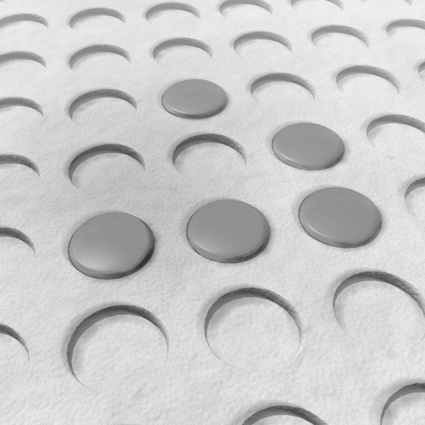Cyberbiodiversity: new life at Casula
Mitchell Whitelaw

Jon McCormack, Eden
During that strange, sunny quiet of the Sydney Olympics, the train journey out to Casula had a tinge of the surreal. It was Spring, the natural time for New Life, the third “capsule” in the Cybercultures: Sustained Release program at the Powerhouse. Rolling through the balmy outer suburbs, you could feel the new life photosynthesising—an ongoing renewal of ancient, carbon-based forms. Inside the wonderfully cavernous gallery, the idea gets a twist; this life is new like a new car, a new TV. It’s crawling around inside ‘new media’, conjured by artists and turned loose inside the computer.
Technosphere III, by British collaborators Jane Prophet, Gordon Selley and Mark Hurry, is one of the ‘classics’ of this decade-old microgenre. The plot is simple: you create an artificial creature from a set of off-the-shelf parts (head, body, mouth, eyes, wheels or legs) and then release it into the wilds of the Technosphere, a vast artificial savanna where thousands of others roam. Life for a technocreature consists of the bare essentials: foraging, eating and procreating. Death is as close as the pointy jaws of the nearest ‘carnivore.’ In its original online incarnation, circa 1996, the Technosphere remained invisible; the system sent out regular emails detailing the artificial life of your cartoon creation. In this newer off-line version, we can follow the creature in real time, watch it shuttling around the plains meeting, eating and having sex with passers-by. This is life in 3D, with hardware acceleration; sharp-edged and fast-paced. Like a game of Quake.
Jon McCormack’s Eden is a more restrained and complex artificial ecosystem. McCormack seems to be moving away from the lush 3D aesthetic of works such as Turbulence; Eden’s visual surface is simple to the point of being diagrammatic. Flickering discs move through a flat matrix of cells, foraging on lichen-like patches of ‘food’; every now and then one of them ‘sings’ an abstract refrain. Like many such works, Eden gets interesting in the longer term, as these artificial organisms adapt to each other and their environment. Equipped with virtual hearing, their behaviour becomes linked to sound—organisms sing to attract a mate, or (altruistically) announce the presence of food. While this sounds like an experiment in cyberbiology, it’s also a manifestation of McCormack’s reflective nature philosophy—in particular a concern about the human need to experience ‘nature’, and the gradual erosion of living environments in favour of their simulations. In this sense the work’s title is highly ambiguous—this little world is complex and engaging, pleasant to see and hear, and like that fabled garden, it’s whole, contained and ordered. On the other hand it’s the merest tracing of the complexity and vitality of a real ecosystem, and it won’t grow us food or generate oxygen; it’s a kind of uninhabitable Eden.
Anita Kocsis’ Neonverte is an electronic garden in a quite different form. Clusters of flickering LEDs line the walls of a darkened space, leading towards a video-projected image. An abstract, low-fi soundtrack meshes with the stuttering 3D wireframes of the video. Layers of meshed trees and flowers scroll by, a bird is frozen on a branch; the virtual space is discontinuous, dissolving into flashing pixel–grids and chunky texture-maps. There is a kind of poetry of digital degradation at work here which sits well with the idea of the garden; Kocsis has generated an electronic mulch which folds familiar nature imagery in with the blank, abject surfaces of wireframe 3D. The technical means are simple enough—no Artifical Life programming here, or complex interactivity—but the result is remarkably poignant.
In Neonverte pixels seem to decay and sprout; so too in Kat Mew’s Muto, an interactive which plays out the fusion of biological matter and digital code. Like Neonverte, Muto does without the A-life processes of Technosphere and Eden; and this seems to leave more space for aesthetic invention. Muto runs in a circular domain, like the view down a microscope. Jittery animation loops slide through 5 elemental domains; cellular blobs fuse, clumps of code shed pixellated numerals; Steve Law’s soundtrack is all funky bleeps. While this cyber-bio mix-up is a familiar story, what marks Muto out is attention to detail: Mew’s animation in particular is intricate and energetic. Its presentation at the Powerhouse matched that level of detail, with video projected onto a weather balloon, wrapping perfectly around to push Muto’s disc-world into a gently swaying, glowing sphere.
If biodiversity is important, perhaps cyberbiodiversity is too. New Life presented an enjoyable balance of approaches, and a mixture of technical and aesthetic concerns. While this stuff is hardly “new life”, it offers imaginings, proposals, for how life and technology might come together—and in that sense diversity is crucial.
New Life. Cybercultures: Sustained Release, curator Kathy Cleland; Casula Powerhouse Arts Centre, Casula, September 30-November 12
RealTime issue #40 Dec-Jan 2000 pg. 21






